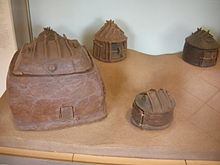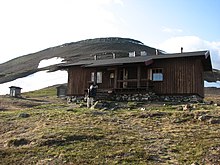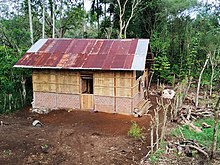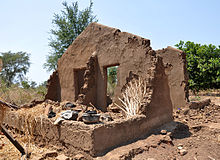Hut
This articleneeds additional citations forverification.(September 2014) |




Ahutis a smalldwelling,which may be constructed of various local materials. Huts are a type ofvernacular architecturebecause they are built of readily available materials such as wood, snow, ice, stone, grass, palm leaves, branches, clay, hides, fabric, or mud using techniques passed down through the generations.
The construction of a hut is generally less complex than that of ahouse(durable, well-built dwelling) but more so than that of ashelter(place of refuge or safety) such as atentand is used as temporary or seasonal shelter or as a permanent dwelling in some indigenous societies.[1]
Huts exist in practically allnomadiccultures. Some huts are transportable and can stand most conditions of weather.
Word
[edit]The term is often employed by people who consider non-western style homes in tropical and sub-tropical areas to be crude or primitive, but often the designs are based on traditions of local craftsmanship using sophisticated architectural techniques. The designs in tropical and sub-tropical areas favour high airflow configurations built from non-conducting materials, which allow heat dissipation. The termhouseorhomeis considered by some to be more appropriate.
In theWestern worldthe wordhutis often used for a woodenshed.
The term has also been adopted byclimbersandbackpackersto refer to a more solid and permanent structure offering refuge. These vary from simplebothies– which are little more than very basic shelters – tomountain hutsthat are far more luxurious and can even include facilities such asrestaurants.
The word comes from the 1650s, from Frenchhutte"cottage" (16c.), from Middle High German hütte "cottage, hut," probably from Proto-Germanic *hudjon-, related to the root of Old English hydan "to hide," from PIE *keudh-, from root (s)keu- (see hide (n.1)). Apparently first in English as a military word. Old Saxon hutta, Danish hytte, Swedish hytta, West Frisian and Middle Dutch hutte, Dutch hut are from High German.Ukrainiankhataseems to be known from even earlier ages. Avestan or ancient Iranian origins presumably. "[2]related tohide,a covering.
Modern use
[edit]




Huts are used by shepherds when moving livestock between seasonal grazing areas such as mountainous and lowlandpastures(transhumance).
They are also commonly used by backpackers and other travelers in rural areas.
Some displaced populations of people use huts throughout the world during adiaspora.For example, temporary collectors in the wilderness agricultural workers at plantations in theAmazonjungle.
Huts have been built for purposes other than as a dwelling such as storage, workshops, and teaching.
Types
[edit]Traditional
[edit]- Bahay kubo– a traditional Filipino stilt house made of bamboo and palm fronds as roofing. They are designed to be lightweight so they can be moved from one place to another by being carried by group of men, a practice commonly calledbayanihan.
- Balok – a Siberianwilderness hutmade of logs, usually communal, used by hunters, fishermen and travelers in the more distant parts of Siberia. Some baloks are mobile and mounted on sleds.
- Barabara– an earth sheltered winter home of theAleut people
- Barracks– an old term for a temporary hut,[1]now more used as a term for military housing and a unique hay storage structure called ahay barrack.
- Bothy– originally a one-room hut for male farm workers in the United Kingdom, now amountain hutfor overnight hikers.
- Burdeior bordei – adugoutorpit-housewith a sod roof in Romania, Ukraine and Canada.
- Cabana– an open shelter
- Chozo – Spanish for hut
- Clochán– Irish dry stone hut
- Dry stone hut
- Earth lodge– Native American dwelling
- Heartebeest Hut– hut used by South AfricanTrekboerbuilt of reeds, sometimes plastered with mud.
- Hytte– Norwegian cabin or hut
- Igloo– a hut made of hard snow or ice
- Kolba– Afghanistan hut
- Khata– Ukrainian traditional whitewashed wattle-and-daub hut, usually with two rooms, loft, and straw roof
- Lodge is a general term for a hut or cabin such as alog cabinorcottage.Lodge is used to refer to a tipi,sweat lodge,and hunting, fishing, skiing, andsafari lodge.
- Mitato– a small, dry stone hut in Greece
- Orri– a French dry stone and sod hut
- Rondavel– Central and South Africa
- Roundhouse (dwelling)– a circular hut or house typically with a conical roof
- Sheiling– originally a temporary shelter or hut for shepherds, now may be a stone building. Common in Scotland.
- Sod house– a pioneer house type on the American Plains where wood was scarce.
- Sukkah– Israel and Jewish diaspora
- Trullo- a dry stone hut inApulia,Italy
- Tule hut– coastal North America, West Coast, Northern California
- Oca– Brazilian hut
- Quinzhee– Canadian snow shelter
- Yurt– Central and North Asia
Modern
[edit]- HORSA hut– a prefabricated school building built to cope with additional demand from theEducation Act 1944.
- Laing hut – a prefabricated lightweight timber wall sections bolted together, externally clad with plasterboard and felt. Designed in 1940 for barrack accommodation.[3]
- Nissen hut– a prefabricated steel structure made from a semicircle of corrugated steel invented 1st quarter 20th century.
- Jamesway hut– a variation of a Nissen hut
- Romney hut– a variation of a Nissen hut
- Quonset hut– a type of Nissen hut of lightweight prefabricated structure of corrugated steel
- Pratten hut– a prefabricated building generally used in schools for classrooms in the UK after World War 2.
- Scout hut– term given for the buildings used as the meeting place of members ofThe Scout Associationworld-wide.
Construction
[edit]
Many huts are designed to be relatively quick and inexpensive to build. Construction often does not require specialized tools or knowledge.[4]
Marketing usage
[edit]The termHutis also used to name many commercial stores, companies, and concepts. The name implies a small, casual venue, often with a fun and friendly atmosphere. Examples includePizza HutandSunglass Hut.Kiosksmay be constructed to look like huts and are often found atparks,malls,beaches, or other public places, selling a variety of inexpensive food or goods. Luxury hotels in tropical areas where guests are assigned to occupy their own freestanding structure sometimes call the structure a "hut", though such huts typically bear little more than superficial resemblance to the traditional concept of a hut.
See also
[edit]
- Architecture of Africa
- Cabane en pierre sắc che – French dry stone huts
- Lean-to– a type of shelter
- Mountain hut– building that provides food and shelter for hikers and mountaineers
- Palloza– Spanish type of roundhouse
- The Primitive Hut– concept in architectural theory
- Tipi– Central North America tent
References
[edit]- ^abOxford English Dictionary Second Edition on CD-ROM (v. 4.0) © Oxford University Press 2009
- ^"Online Etymology Dictionary".etymonline.Retrieved2015-03-15.
- ^"Warwickshire County Council Museum: Laing hut".Retrieved27 January2016.
- ^[1]Using Natural Terrain to your Advantage

